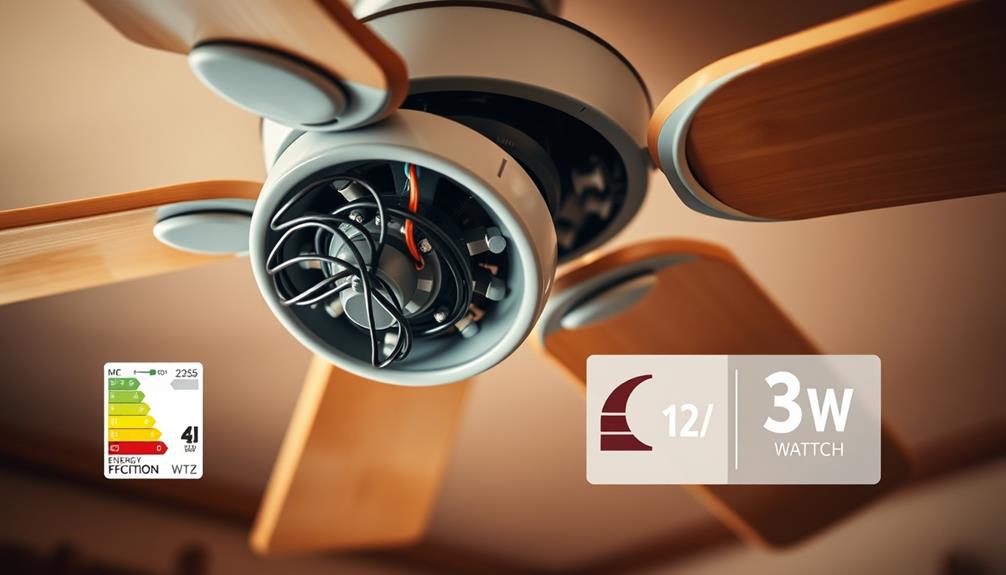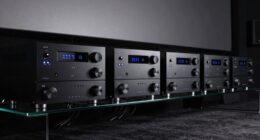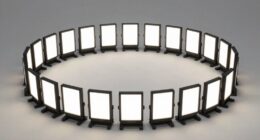Uncovering the secrets of ceiling fan wattage can help you save on energy costs. You'll find that lower wattage ratings reduce electricity bills while higher airflow guarantees ideal cooling. Remember, fan size and speed greatly impact power usage. Larger fans usually consume more watts, and higher speeds require even more energy. Choosing energy-efficient models, like those with DC motors or Energy Star certification, makes a difference. Regular maintenance also plays an essential role in enhancing efficiency. By considering wattage alongside airflow, you can choose the best fan for your needs, making your home more comfortable and cost-effective. Curious about further insights?
Key Takeaways
- Wattage ratings indicate energy consumption; lower wattage often correlates with reduced electricity costs and improved efficiency.
- Fan speed directly impacts wattage; higher speeds consume more energy, so balance cooling needs with efficiency.
- Larger fans generally use more energy, so consider fan size in relation to your space for optimal efficiency.
- Energy Star certified fans meet strict efficiency guidelines, ensuring better performance and lower energy bills.
- Regular maintenance, such as cleaning blades and lubricating motors, enhances fan efficiency and prolongs lifespan.
Energy Consumption Basics

When considering ceiling fans, it's crucial to grasp the basics of energy consumption. Understanding how much energy your fan uses can help you make informed choices.
Look for energy-saving technologies like LED lighting, which consumes less energy than traditional bulbs. Choosing fans with DC motors can also be a game-changer; these motors are up to 70% more efficient than AC motors.
Remember to evaluate wattage, airflow (CFM), and how long you'll use the fan each day. Lower wattage ratings can greatly cut energy costs, while higher airflow ratings guarantee ideal circulation.
Always check for Energy Star certification, as it assures compliance with energy efficiency guidelines. These factors will help you choose a ceiling fan that saves energy without compromising performance.
Key Factors Influencing Wattage

Several key factors influence the wattage of ceiling fans, impacting their energy consumption and overall performance. The type of fan model, fan speed, size, and motor capacity all play significant roles. Advanced features like remote controls or integrated lighting can also increase wattage usage.
Here's a quick overview of factors affecting ceiling fan wattage:
| Factor | Impact on Wattage |
|---|---|
| Fan Model | Energy-efficient models consume less |
| Fan Speed | Higher speeds use more energy |
| Fan Size | Larger fans typically draw more power |
| Motor Capacity | More powerful motors consume more watts |
| Additional Features | Features like lights increase wattage |
Calculating Average Energy Usage

To effectively calculate average energy usage for ceiling fans, you need to take into account both the wattage rating and the duration of operation.
Modern Energy Star certified fans can greatly enhance your energy savings by allowing you to raise your thermostat temperature by 4°F while still maintaining comfort.
First, find the wattage rating of your ceiling fan—this is usually listed on the fan itself or in the manufacturer's specifications. Next, determine how many hours you typically run the fan each day.
Multiply the wattage by the hours of use to get the daily energy consumption in watt-hours. For example, if your fan uses 60 watts and runs for 5 hours, it consumes 300 watt-hours daily.
To estimate monthly usage, multiply your daily consumption by 30. This calculation helps you understand your fan's energy costs and allows you to make informed decisions about usage, particularly when considering increased fan efficiency.
Selecting Energy-Efficient Fans
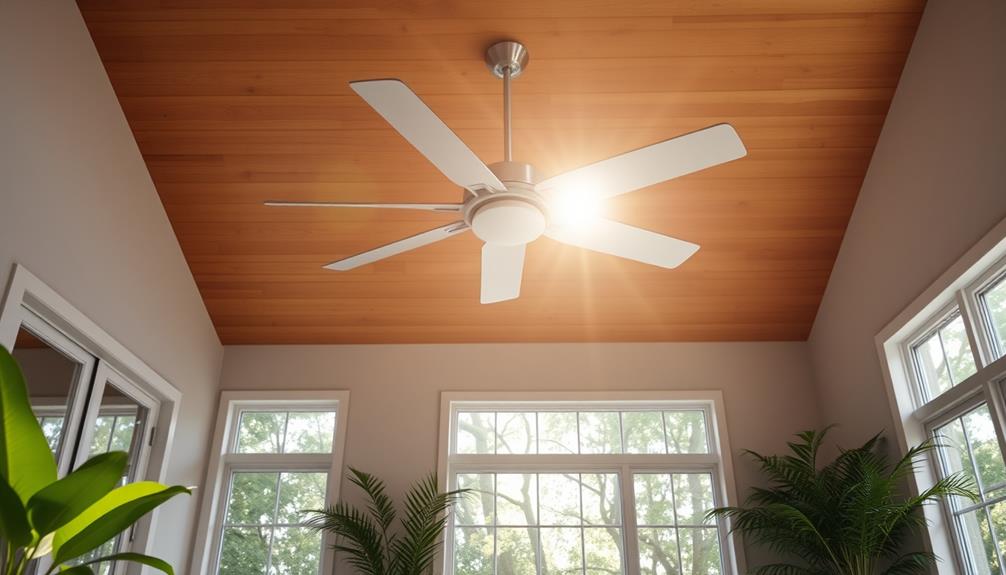
Choosing energy-efficient ceiling fans can greatly cut down your electricity bills while keeping your space comfortable. When selecting a fan, look for models that feature optimized blade designs and lower wattage ratings, as these indicate better energy efficiency.
Additionally, consider the impact of air quality considerations on your indoor environment, as a well-ventilated space can complement the cooling effects of your ceiling fan. Check for built-in energy-saving features like programmable timers and variable speed controls, which let you adjust settings based on your needs.
Compare energy consumption ratings among different fan models to find the most efficient option. Additionally, consider the fan size and speed settings suitable for your room dimensions; this guarantees maximum airflow without excessive energy use.
Regular maintenance, like dusting blades and lubricating motors, also helps maintain efficiency, extending the life of your fan while keeping energy costs low.
Wattage and Speed Dynamics
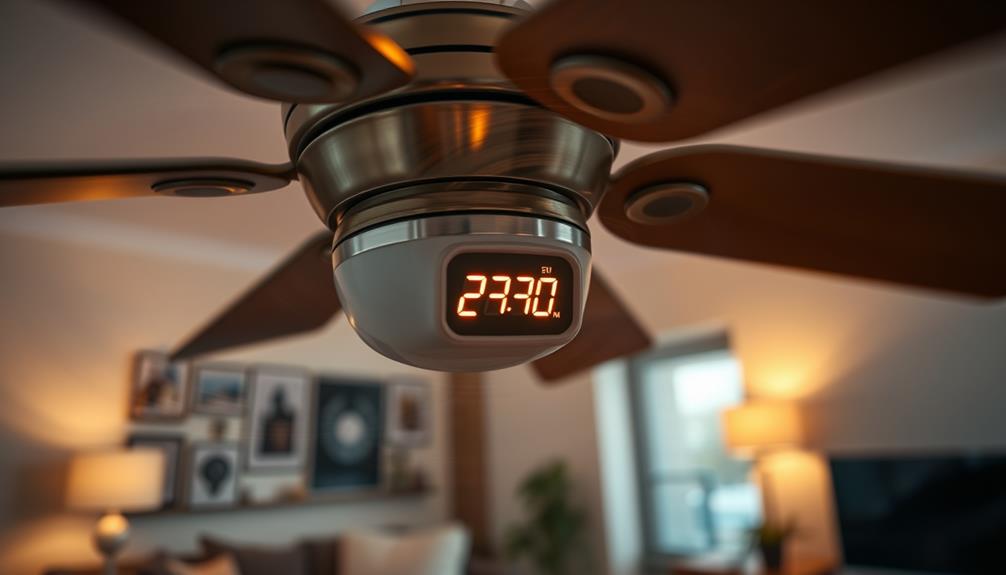
Understanding how wattage and speed interact can greatly enhance your ceiling fan's performance. When you increase the fan speed, wattage consumption also rises, meaning higher energy bills if you're not careful.
It's crucial to choose the right speed setting for your specific cooling needs. Many fans offer multiple speed options, allowing you to balance comfort and energy efficiency.
Additionally, just as with toilet flushing efficiency, lower speeds consume less wattage, making them ideal for mild days. Conversely, higher speeds can deliver a powerful breeze when it's hot, but they require more energy.
Keep in mind that an efficient fan design can produce significant airflow without needing excessive wattage. By recognizing these dynamics, you can optimize your fan's performance while keeping energy costs in check.
Maintenance for Efficiency
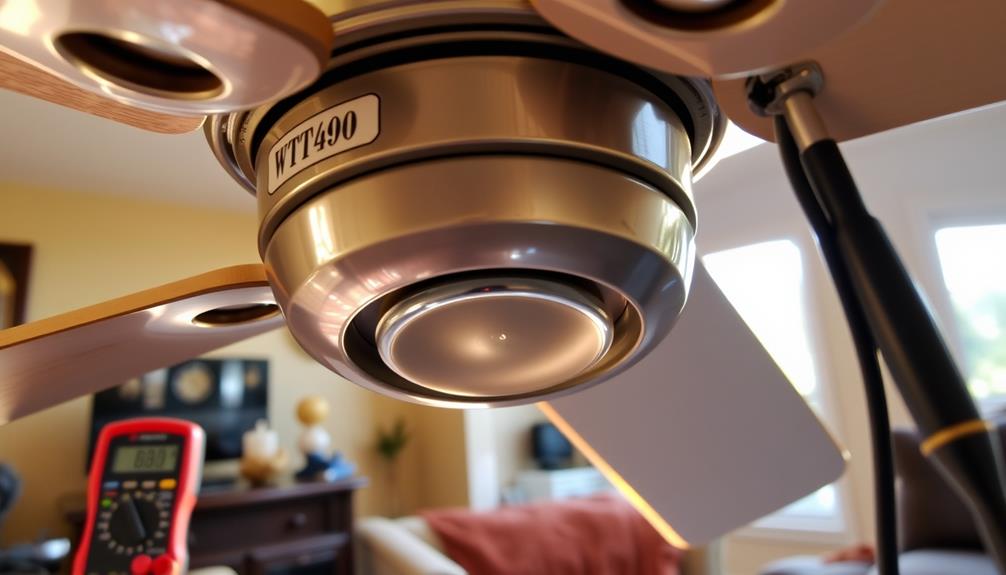
Regular maintenance can greatly enhance your ceiling fan's efficiency and lifespan. To keep your fan running smoothly, you should clean the blades regularly to prevent dust buildup, which can impede airflow. Lubricating the motor and checking for loose screws will also help maintain peak performance.
Here's a quick reference table for effective maintenance tasks:
| Maintenance Task | Frequency |
|---|---|
| Clean Fan Blades | Monthly |
| Lubricate Motor | Every 6 months |
| Check for Loose Parts | Every Year |
Understanding Cooling Effectiveness
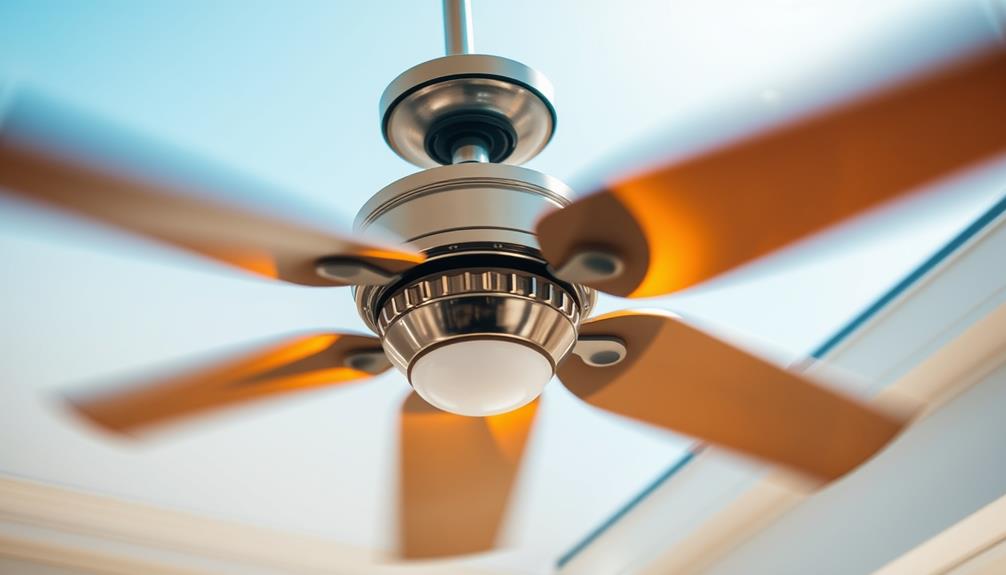
While many people think higher wattage translates to better cooling, it's important to take into account how fan design and blade pitch also play crucial roles in airflow efficiency.
A fan's ability to cool your space depends on its airflow measured in cubic feet per minute (CFM), not just its wattage. You'll want to choose a fan that balances wattage with ideal CFM ratings for your room size.
Additionally, using multiple speed settings allows you to adjust airflow without drastically increasing wattage consumption.
Remember, a well-designed fan can circulate air effectively at lower wattages, providing better cooling while saving energy.
Frequently Asked Questions
How Does Ceiling Fan Wattage Affect Overall Home Energy Costs?
Ceiling fan wattage directly impacts your home's energy costs. Lower wattage fans consume less electricity, leading to savings on your bills. Choosing energy-efficient models guarantees effective cooling without greatly increasing your overall power consumption.
Can Ceiling Fans Replace Air Conditioning in Summer?
Sure, you could use a ceiling fan instead of air conditioning—if you enjoy the lovely, subtle scent of sweat! But for real cooling, fans work best alongside AC for ideal relief during scorching summer days.
What Are the Environmental Benefits of Energy-Efficient Ceiling Fans?
When you choose energy-efficient ceiling fans, you reduce electricity consumption, lower your utility bills, and decrease greenhouse gas emissions. This choice contributes to a healthier environment, promoting sustainability while keeping your space comfortable and stylish.
How Can I Determine the Right Fan Size for My Room?
To determine the right fan size for your room, measure the space's square footage. For ideal airflow, choose a fan with a diameter that matches your room size, ensuring efficient circulation and comfort.
Do Ceiling Fans Help With Winter Heating Efficiency?
Isn't it surprising how a ceiling fan can actually help with winter heating? By reversing the blade direction, you push warm air down, making your space cozier while using less energy. It's a smart move!
Conclusion
By grasping the nuances of ceiling fan wattage, you're not just spinning blades; you're crafting a sanctuary of comfort and savings. Armed with this knowledge, you can dance through the aisles of options, selecting fans that whisper efficiency while cooling your space. Remember, every watt counts in your quest for a sustainable lifestyle. So, embrace this journey, and let your choices illuminate your home with both comfort and eco-friendliness, turning each room into a rejuvenating oasis. As you explore the benefits of ac ceiling fans, you’ll find that they not only provide energy-efficient cooling but also help to circulate air and create a more comfortable environment. With their low energy consumption, ac ceiling fans can contribute to significant cost savings on your energy bills. By incorporating these fans into your home, you can elevate your space with both style and sustainability, making every watt count towards a brighter, greener future.
